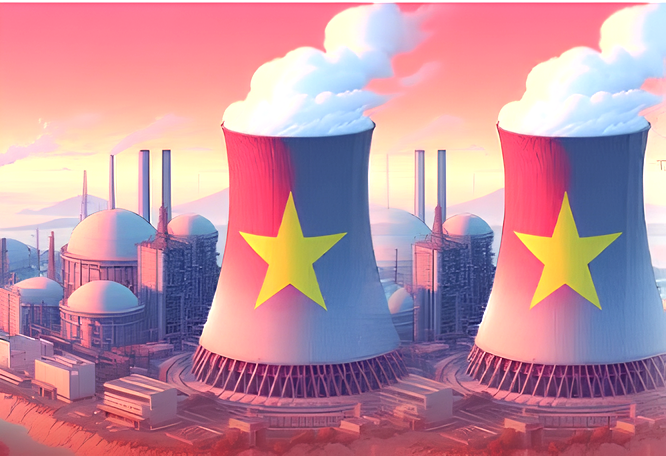Three Main Axes for the Development of the Ninh Thuan Nuclear Power Plant
After nearly a decade of hiatus, the Ninh Thuan Nuclear Power Plant – Vietnam’s first nuclear power project in history – is being restarted thanks to strategic goals and policies from the Central Government.

AI-generated image.
To bring nuclear power – a clean, carbon-free energy source – into commercial operation before 2040, Vietnam needs to take decisive and clear-cut actions.
According to Notification No. 395/TB-VPCP dated August 4, 2025, issued by the Government Office, Deputy Prime Minister Bui Thanh Son stated:
The Ninh Thuan Nuclear Power Plant (comprising two plants, Ninh Thuan 1 and 2, with a total capacity of 4,000 Megawatts) will be developed along three main axes: Land clearance; International negotiation; and Investment.
| Item | Details | Deadline |
|---|---|---|
| Land clearance | The People’s Committee of Khanh Hoa province (newly merged with Ninh Thuan province) will take charge of relocating and compensating residents, as well as providing new settlements; handing over cleared land, and quickly stabilizing livelihoods for families in their new locations to ensure no disruption to local production, business, and people’s lives. | Within 2025 |
| International negotiation | The Ministry of Industry and Trade will coordinate with the Vietnam Electricity Group (EVN) and the Vietnam National Oil and Gas Group (Petrovietnam) to negotiate and sign intergovernmental agreements. |
– Ninh Thuan 1: August 2025 – Ninh Thuan 2: by May 2026 at the latest |
| Investment research | EVN and Petrovietnam to submit pre-feasibility study reports. |
– Ninh Thuan 1: September 2025 – Ninh Thuan 2: by June 2026 at the latest |
Vietnam needs to complete this key national project as soon as possible, not only to ensure energy security and promote socio-economic development towards sustainability but also to affirm its commitment to the Net Zero 2050 emission target and keep up with global trends in the peaceful use of nuclear energy.
The Top 15 Countries with the Largest Nuclear Power Generation in the World
According to the latest World Energy 2025 World Energy Statistics report, global nuclear power generation reached 2,818 terawatt-hours (TWh) in 2024.
The US – the nuclear power leader – produced 823 TWh, accounting for 29.2% of global nuclear power generation.
China ranked second with 451 TWh (16%), followed by France with 381 TWh (13.5%). Russia, South Korea, and Canada are in the top 6, together accounting for nearly 17% of global nuclear power generation.
UAE witnessed the fastest growth among major producers, increasing by 17.6% compared to the same period in 2023 as more new reactors are being built.
See the figure below:

Chart showing the top 15 countries with the largest nuclear power generation and the rest of the world.
The World Nuclear Association states that nuclear power development is a global endeavor. As of July 2025, nuclear energy provides about 9% of the world’s electricity from approximately 440 operating reactors, with a total capacity of 400 Gigawatts (GW).
There are 65 additional reactors under construction and 86 planned globally.
According to the Multidisciplinary Digital Publishing Institute (MDPI, Switzerland), nuclear energy for peaceful purposes meets the demand for clean energy and promotes progress in science, medicine, agriculture, and industry, contributing to a sustainable future.
MDPI analysis: Nuclear energy is considered crucial to achieving deep decarbonization and limiting global temperature rise.
The International Energy Agency (IEA) points out that meeting the pace of CO2 emissions reduction set out in the Paris Agreement on Climate Change presents a significant challenge. Achieving these goals requires improving efficiency, increasing investment in renewable energy, and expanding the use of nuclear power.
Notably, nuclear power plants emit similar amounts of CO2 emissions per unit of electricity as wind power over their life cycle and about one-third of that of solar power.
Unlike renewable energy, nuclear power plants maintain continuous electricity generation, providing a stable power supply – a distinct advantage over the intermittent nature of wind and standalone solar PV power.
In addition to clean electricity production, the peaceful use of nuclear energy has significantly improved human life in medicine, agriculture, food preservation, industry, and scientific exploration. Nuclear technology plays a crucial role in cancer diagnosis and treatment, X-ray imaging, blood irradiation, and biological sterilization. It also contributes to scientific understanding of environmental issues such as climate change.
Revolutionizing Vietnam’s Infrastructure: Deo Ca’s Visionary Proposal for a $25.5 Billion Transport Network Revolution
“Recently, a delegation from Deo Ca Group, led by its Chairman, Mr. Ho Minh Hoang, engaged in a productive meeting with the Asia-Pacific Institute for Sustainable Development, Hoa Thiet Ke Design Group, and the China Railway Design Consulting Group. The gathering aimed to explore potential collaboration opportunities between the participating entities.”
South Korea and Vietnam: A United Front, Signing 10 Agreements to Strengthen Bilateral Ties
“As part of his state visit to South Korea, on August 11, Party General Secretary To Lam and South Korean President Lee Jae-myung, along with high-ranking delegations from both countries, witnessed the signing of several bilateral cooperation documents across various fields, further strengthening the Vietnam-South Korea partnership.”
Two Scenarios for Optimizing Operations at Long Thanh and Tan Son Nhat Airports from 2026 Onwards
The ACV has proposed two options for operations: transferring all international flights to Long Thanh once the new airport is operational, or retaining short-haul flights at Tan Son Nhat.












































